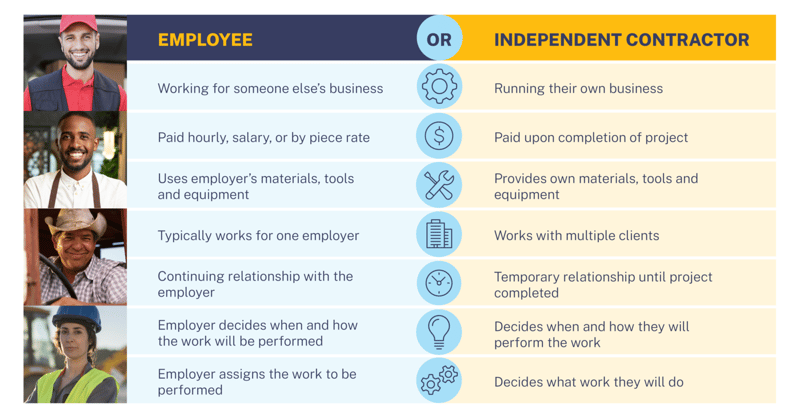Worker Misclassification Hurts the Construction Industry
Worker misclassification is a serious problem in the construction industry that often goes unchecked and unpunished. Penalties for misclassifying employees as independent contractors can be severe, but unfortunately, the risk of getting caught has historically been minimal. The payoff for unscrupulous business owners who purposely misclassify workers can be enormous. It’s a classic risk vs. reward scenario where, for the most part, the rewards for purposely misclassifying workers as independent contractors far outweighed the risks of getting caught.
In addition to saving on labor costs such as having to pay Social Security and Medicare taxes along with state and federal unemployment taxes, employers aren’t obligated to verify employment eligibility for workers or provide overtime pay or even pay minimum wage. Because labor costs are factored into bids for construction work, it can lead to contractors who misclassify workers being able to submit substantially lower bids on projects to undercut the competition while still remaining profitable. The independent contractors, often referred to as 1099ers, are required to pay the full amounts owed for Social Security, Medicare, and federal income taxes and aren’t eligible to receive unemployment benefits.
So how prevalent is the practice of misclassifying employees as independent contractors in the construction industry? Unfortunately, because regulation and enforcement of proper worker classification have been so lax over the years, agencies weren’t keeping any records on the number of cases or frequency of occurrences. The last time the Internal Revenue Service (IRS) conducted a comprehensive estimate of misclassification was in 1984. At the time they estimated about 15% of employers misclassified 3.4 million workers across all industries.
One of the goals of the IRS’ Employment Tax National Research Program, which began in February 2010, was to look into worker misclassification. The results of those audits weren’t going to be available until this year at the earliest so it’s been over 30 years since the IRS has bothered to see if worker misclassification has gotten any worse over the years. The Department of Labor commissioned a study in 2000 to determine the extent of worker misclassification. Firms from nine states were audited and it was determined that 10 to 30% of those firms misclassified at least some of their employees.
So, the two federal agencies tasked with making sure employers are following the various tax and labor laws associated with worker classification aren’t keeping track of instances of worker misclassification. Not only that but the Government Accountability Office released a report in August 2009 indicating that the DOL and the IRS were doing little to educate employers and workers on proper worker classification and were doing very little to punish those who failed to properly classify workers. The report found that the majority of employers the IRS determined had misclassified workers were small businesses and it wasn’t cost-effective to refer them for examination. The Wage and Hour Division (WHD) of the DOL levied fines on less than 2% of cases involving worker misclassification in fiscal year 2008. In many instances where the WHD determined that back wages were owed they close the cases without bothering to follow up to see if those wages were paid and if the workers were ever properly classified. Until a few years ago, these two agencies weren’t even sharing information on worker misclassification.
Last year, newspaper publisher The McClatchy Company released a report entitled “Contract to Cheat” which was the result of a yearlong investigation into worker misclassification in the construction industry. The investigation focused on federal housing projects from 28 states that for the most part were funded in whole or part by the economic stimulus package of 2009. The investigators reviewed payroll records from these projects and interviewed hundreds of workers and employers. The rate of misclassification of construction workers varied by state but was as high as 35.2% in North Carolina and 37.7% in Texas.
The investigation by The McClatchy Company’s newspapers also revealed incidences of other fraud such as kickbacks where workers were required to cash their checks and pay back the employer a percentage of their income as well as a scam known as “the Florida Plan” where contractors would rent the name of a shell company who had purchased a cheap workers’ compensation policy in order to avoid paying high premiums for workers’ comp and to keep their workers off the books. In Florida, contractors are required to carry workers’ compensation insurance coverage on all their workers, both employees, and independent contractors.
In recent years federal and state agencies have been doing more to ensure compliance with labor and tax laws and to reduce the misclassification of employees as independent contractors. In 2011, the IRS and DOL signed a Memorandum of Understanding (MOU) to improve information sharing and collaboration to combat worker misclassification. In September, Vermont became the 26th state to sign an MOU with the DOL to protect employees from being misclassified.
Since 2007, over half the states have passed legislation aimed at ending misclassification with harsh punishments for companies who willfully misclassify employees as independent contractors. Some have established task forces to audit and investigate possible instances of worker misclassification. States like Delaware, New York, Illinois, Maine, Maryland, New Jersey, and Pennsylvania have worker misclassification laws targeted directly at the construction industry.
These efforts appear to be making a difference. In 2014, the New York Joint Enforcement Task Force on Employee Misclassification identified roughly 26,000 instances of worker misclassification and nearly $316 million in unreported wages. Since August 2007, they have identified around 140,000 instances of worker misclassification and nearly $2.1 billion in unreported wages.
How can you tell if a worker should be an employee or an independent contractor? The following was pulled from a DOL Fact Sheet outlining the factors used to determine whether an employment relationship exists:
Here are two examples that better highlight the differences between employees and independent contractors:
Example 1: Painter Bill is hired to work on a renovation project for an apartment complex. The employer that hired Painter Bill has a crew of painters made up of employees and independent contractors. The employer supplies Painter Bill with all the tools and materials he needs to complete the jobs. The employers expect painter Bill to be on the jobsite working Monday through Friday from 7:00 a.m. to 4:00 p.m. Painter Bill is only paid for the hours he works and is sometimes required to work overtime. The employer has someone checking in on Painter Bill and the other painters to make sure they are working and staying on schedule. Painter Bill is should be classified as an employee.
Example 2: Painter Bob is hired to work on a renovation project for an apartment complex. The employer and Painter Bob agree on his fee and completion prior to beginning any work and he is the only painter on the job. Painter Bob is responsible for purchasing all the paint for the projects as well as any other tools and materials such as brushes, tape, drop cloths, etc. Painter Bob has access to the jobsite Monday through Friday from 7:00 a.m. to 4:00 p.m., but can come and go as he pleases and he is free to take on other painting jobs in addition to this one. Painter Bob will either make a profit or suffer a loss depending on how he manages his time and costs on this job. Painter Bob should most likely be classified as an independent contractor.
Worker misclassification is a black eye on the construction industry. It’s hard to attract new workers if the industry has a reputation of trying to cheat workers of benefits by not abiding by applicable tax and labor laws. It also creates an uneven playing field because the unethical business owners that are labeling employees as independent contractors are saving up to 20% percent on labor costs which they can in turn use to undercut bids by those companies playing by the rules and treating their employees fairly.
